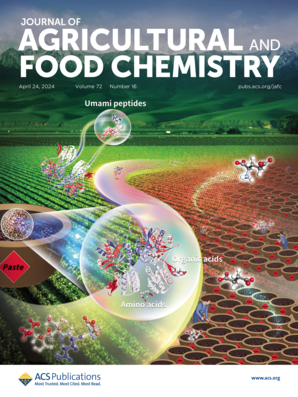金桔类黄酮通过上调MicroRNA-145抑制NLRP3炎性体的激活,减轻ApoE - / -小鼠动脉粥样硬化
IF 5.7
1区 农林科学
Q1 AGRICULTURE, MULTIDISCIPLINARY
引用次数: 0
摘要
动脉粥样硬化(AS)被广泛认为是慢性炎症的结果,核苷酸结合寡聚化结构域样受体蛋白3 (NLRP3)炎症小体在介导这种炎症反应中起着关键作用。金桔黄酮(KFs)是金桔中的主要活性成分,已被证明具有调节炎症和预防AS的潜力。本研究旨在通过高脂/高胆固醇饮食(HFCD)的ApoE - / -小鼠模型和氧化低密度脂蛋白(ox-LDL)诱导的小鼠主动脉血管平滑肌细胞(MOVAS)炎症模型,探讨KFs对AS的保护作用及其机制。我们的研究结果表明,KFs显著降低了ApoE - / -小鼠的血脂水平,并抑制了炎症细胞因子的过度产生。值得注意的是,KFs还减少了ApoE - / -小鼠主动脉动脉粥样硬化病变面积和斑块形成。此外,在体内(小鼠主动脉组织)和体外(MOVAS细胞),KFs被发现抑制NLRP3炎性体的激活,同时上调microRNA-145 (miR-145)。综上所述,我们的研究结果表明KFs通过上调miR-145对NLRP3炎性体发挥抑制作用,从而缓解AS的进展。本文章由计算机程序翻译,如有差异,请以英文原文为准。

Kumquat Flavonoids Attenuate Atherosclerosis in ApoE–/– Mice by Inhibiting the Activation of NLRP3 Inflammasome through Upregulating MicroRNA-145
Atherosclerosis (AS) is widely recognized as a consequence of chronic inflammation, with the nucleotide-binding oligomerization domain-like receptor protein 3 (NLRP3) inflammasome playing a pivotal role in mediating this inflammatory response. Kumquat flavonoids (KFs), the primary active ingredients in kumquat, have demonstrated potential in modulating inflammation and may help prevent AS. Herein, this study aimed to explore the protective effects and underlying mechanisms of KFs on AS using an ApoE–/– mouse model fed a high-fat/cholesterol diet (HFCD) and the mouse aortic vascular smooth muscle cell (MOVAS) inflammation model induced by oxidized low-density lipoprotein (ox-LDL). Our results show that KFs significantly reduced serum lipid levels and suppressed the overproduction of inflammatory cytokines in ApoE–/– mice. Notably, KFs also decreased the area of atherosclerotic lesions and plaque formation in the aorta of ApoE–/– mice. Additionally, in vivo (mouse aortic tissue) and in vitro (MOVAS cells), KFs were found to inhibit the activation of NLRP3 inflammasome and simultaneously upregulate microRNA-145 (miR-145). In conclusion, our findings suggest that KFs exert their inhibitory effects on NLRP3 inflammasome through upregulating miR-145, thereby alleviating the progression of AS.
求助全文
通过发布文献求助,成功后即可免费获取论文全文。
去求助
来源期刊
CiteScore
9.90
自引率
8.20%
发文量
1375
审稿时长
2.3 months
期刊介绍:
The Journal of Agricultural and Food Chemistry publishes high-quality, cutting edge original research representing complete studies and research advances dealing with the chemistry and biochemistry of agriculture and food. The Journal also encourages papers with chemistry and/or biochemistry as a major component combined with biological/sensory/nutritional/toxicological evaluation related to agriculture and/or food.

 求助内容:
求助内容: 应助结果提醒方式:
应助结果提醒方式:


